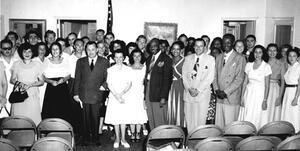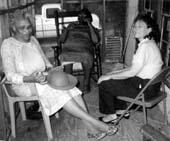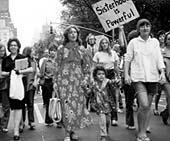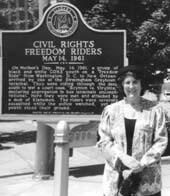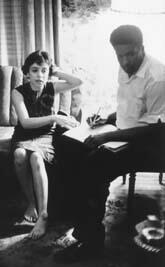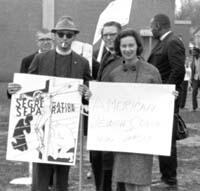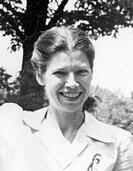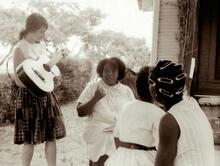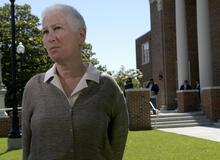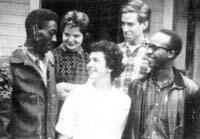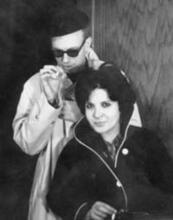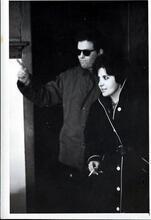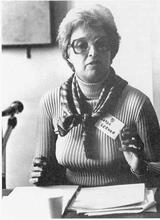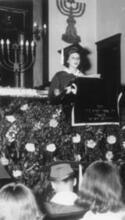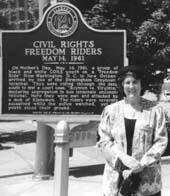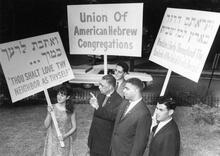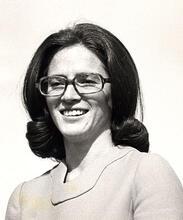Civil Rights Movement in the United States
Jewish women put their lives on the line to fight racism and white supremacy in the Southern civil rights movement and contributed professional skills and organizational clout to move the civil rights agenda forward throughout the country. In Black-led organizations like CORE (the Congress of Racial Equality) and SNCC (the Student Nonviolent Coordinating Committee), Jewish women participated in the Freedom Rides and sit-ins, went to jail, joined the SNCC staff, registered voters, taught in Freedom Schools, marched in Washington, DC, and bound tired feet on the Selma to Montgomery march. In Jewish organizations like the American Jewish Congress and women’s organizations like the National Council of Jewish Women and the Emma Lazarus Clubs, Jewish women mobilized broad support for racial equality.
Black-Jewish Alliances
Historians continue to debate the reasons for the disproportionate role of Jewish Americans in the twentieth-century civil rights movement. Often-cited “bonds” between Jewish Americans and African Americans include a shared though different historical experience of slavery; long-standing experiences of discrimination and social marginalization; religiously grounded impulses toward social justice; and the need to affirm group identity in relation to the dominant culture. Scholars exploring the implications of Jewish assimilation and access to “whiteness” underscore divergences between the two communities. Indeed, the very concept of a naturalized Black-Jewish alliance erases Jews of color, whom scholars and communities increasingly recognize. Some argue that Jewish liberals embraced civil rights in a self-interested way because it helped them seem more American. Others note the spectacular socioeconomic rise of American Jews in the twentieth century, which often created economic conflict between Black people and Jews. Once restrictive covenants against Jews were eased, Ashkenazi Jews with white skin privilege were able to blend into wealthier suburbs, sometimes retaining property and businesses in African American urban communities. These divergent economic interests caused tension. Nonetheless, the Jewish community remained markedly liberal over the course of the twentieth century, and Jewish women’s civil rights activism played a specific part in that tendency.
Though there is widespread awareness of the Jewish community’s significant contributions to the civil rights movement, the documentary record and public perception continue to reflect the roles and experiences of men. Scholarship in American Jewish history, civil rights history, and gender studies rarely addresses the contributions of Jewish women. While Jewish women civil rights activists shared some motivations with Jewish men, the gender dynamics of the Jewish community and twentieth-century American life also inflected Jewish women’s reasons for getting involved. Often shut out of leadership in Jewish organizations, Jewish women founded their own organizations and reached out to other women reformers across racial, ethnic, and religious lines. Gender politics also influenced younger Jewish women college students to respond when the movement put out the call in the 1960s.
Historically, Jewish organizations were early supporters of civil rights. Yet even within the Jewish organizational world, differences of national origin, class, and gender arose. Founded by earlier nineteenth-century German Jewish immigrants, organizations like the American Jewish Committee and the National Council of Jewish Women often had paternalistic attitudes toward later Eastern European Jewish migrants. Seeing their mission as facilitating integration and assimilation into mainstream American society, these organizations tended to take a more cautious approach to civil rights. The American Jewish Congress and the Anti-Defamation League took a more progressive stance in their anti-discrimination work, and women-specific organizations like the Emma Lazarus Federation of Jewish Women’s Clubs were downright radical.
Historians now use terms such as “the long civil rights movement” and the “Black Freedom Struggle” to highlight the fact that African Americans and their allies started to protest racial injustice long before the classic civil rights movement periodization from the Supreme Court’s 1954 Brown v. Board of Education decision declaring segregation unconstitutional to the passage of the 1964 Civil Rights Act and the 1965 Voting Rights Act. Many view the twenty-first century’s Movement for Black Lives as continuous with or a second iteration of the mid-twentieth century civil rights movement. Nonetheless, even a focus on the classic 1954 to 1965 era reveals Jewish participation in numbers greater than their proportion in the population.
During the 1960s, Jewish women contributed to the civil rights movement in myriad ways in all parts of the country. An older, more middle and upper-class group participated through Jewish communal organizations, synagogues, and civil rights organizations, and in their professional capacities as lawyers, doctors, social workers, and educators. A younger cohort engaged in on-campus student activism, including Hillel; unaffiliated participation in sit-ins and other demonstrations; and finally, by going South personally as Freedom Riders, staff members of SNCC (the Student Nonviolent Coordinating Committee) and CORE (the Congress of Racial Equality), and as volunteers in the 1964 Mississippi Freedom Summer and Selma campaigns. The more secular, younger, working- and lower-middle-class Jewish women drawn to nonviolent direct action gravitated to radical, black-led organizations, which created a space for them to participate.
Motivations for Civil Rights Activism
Jewish women who went South demonstrated a willingness to put their bodies on the line to fight racism. This was a transgressive act on a number of levels. First, it remains extraordinary for any white person in the United States to be a “race traitor,” risking their life to challenge white supremacy. For Jews, with a complicated historical relationship to whiteness, this was particularly striking. Second, for women, going South directly challenged traditional gender roles before the second wave of the women’s movement made such challenges less individualized acts. Finally, going South required negotiating Jewish cultural and political ambivalence about becoming visible as critics of American society. This was precisely what many of the women’s second-generation parents, engaged in the project of assimilation and upward mobility, most feared, even as they recognized that their daughters were acting with the moral values they had learned at home.
Several facets of mid-century American Jewish life fostered identification of Jewish women with the Black struggle. One dimension was the closeness of some activists’ families to poverty and struggle. Several Jewish women SNCC activists came from divorced, woman-headed households, which only highlighted their “otherness” in the 1950s. Sometimes that sense came with feeling marginalized as Jews. Some future civil rights workers experienced blatant antisemitism, often for the first time, when they went away to college. Women such as Vivian Leburg Rothstein (b. 1946), the child of refugees from Nazism, and Trudy Orris (1916-2004), an Army wife who had visited the newly liberated concentration camps in Germany in 1946, directly tied their antiracist activism to close encounters with the Holocaust.
Even the most secular Jews were familiar with the prophetic Jewish social justice tradition. Despite varying degrees of separation from religious Judaism, the Jewish backgrounds, traditions, politics, and values of Jewish women civil rights activists did shape their worldviews and commitments. Some, but not all, were children of Old Left families, whose activism was in keeping with family values. Others came from liberal Democratic families who retained a sense of tikkun olam (Hebrew for “repair of the world”), which suggests a special Jewish concern with social justice.
Many future Jewish women activists also experienced a contradiction between the Jewish familial expectation of attaining higher education and the 1950s cultural norm in which women were supposed to stay home and raise families. Furthermore, Jewish women have traditionally been expected to work and to take care of family businesses, albeit to facilitate men’s Lit. "teaching," "study," or "learning." A compilation of the commentary and discussions of the amora'im on the Mishnah. When not specified, "Talmud" refers to the Babylonian Talmud.Talmud study and spiritual development. This history meshed nicely with the need for Jewish women (as white women) to play responsible but heretofore invisible roles in the Black-led civil rights movement.
Jewish Women’s Contributions to the Movement’s Nonviolent Direct-Action Wing
The focus of organizations such as SNCC and CORE on nonviolent direct action gave progressive Jewish women an opportunity to rise to Rabbi Hillel’s famous challenge: “If I am not for myself, who will be for me? If I am only for myself, what am I? If not now, when?” It also gave them permission and a framework in which to take action.
Jewish women who found their way to the southern movement had to juggle multiple senses of identity. They were relatively privileged, well-educated northern students who could choose to come South to work in a social justice movement; they were the children of Jews struggling to assimilate into American society without losing their Jewish connection; they were women from families and a culture that both encouraged and limited their life choices; they were white women in a movement led most visibly by Black men; they were competent and experienced women willing to take action before the feminist movement made it legitimate to do so; and they were secular Jews in a Black Christian movement working in the antisemitic and virulently racist and sexist South.
Carol Ruth Silver (b. 1938) responded to CORE’s 1961 radio call for freedom riders to challenge segregation on interstate buses. She was the only woman on her multiracial freedom-riding bus. Arrested in Jackson, Mississippi, on June 7, 1961, Silver spent the next forty days in jail at the infamous Parchman Prison. After the first few days, she was joined by thirteen more white women freedom riders, over half of them Jewish. The young women entertained themselves by reading, doing exercises, and playing chess (Silver fashioned a chess set out of white bread—it now resides in the Mississippi Civil Rights Museum). They debated the philosophy of nonviolence, learned to collaborate with Black women activists jailed in nearby (segregated) cells, and developed the sensitivity and skills to be northern white allies in a Black-led Southern movement.
The kinds of roles Jewish women played when they went South for civil rights helped build the infrastructure of a remarkably effective movement that transformed the country despite modest human and financial resources. They managed and connected people, money, and information. Jewish women worked as demonstrators and desegregators, voter registration workers, fieldworkers and organizers, Freedom School teachers, policy analysts, strategists, communications coordinators, fundraisers, human resource managers, economic cooperative organizers, typists, cooks, and sympathetic listeners.
New Yorker and budding journalist Dorothy Miller Zellner (b. 1938) embraced her behind-the-scenes role and still considers serving on the SNCC staff as a privilege. In 1960, she learned nonviolent resistance techniques during a summer CORE workshop, going to jail in Miami. She returned to Atlanta in 1961 to do research for the Southern Regional Council and volunteered for SNCC. She soon became SNCC’s first Jewish woman staff member. Her writing skills led to an assignment working with Julian Bond to build SNCC’s communications and outreach efforts. She and her former husband, Robert Zellner (SNCC’s first white field secretary), remained among SNCC’s inner circle until 1967, when it was decided that only African Americans should serve on the SNCC staff.
Jewish Women’s Organizational Contributions
Women working in the organized Jewish world were equally ahead of their times. Before much of organized Jewry publicly addressed civil rights issues, the National Council of Jewish Women lobbied against lynching and the poll tax. The American Jewish Congress Women’s Division was also active in civil rights issues. Jacqueline Levine (b. 1926), whose mentor was Rabbi Joachim Prinz, a speaker at the 1963 March on Washington, represents a liberal trajectory in American Jewish organizational life. She joined the American Jewish Congress to protest McCarthyism and represented the AJC at the 1963 March on Washington and at the 1965 Selma to Montgomery march. On the more progressive end of the spectrum, the Emma Lazarus Federation of Jewish Women’s Clubs held interracial luncheons; wrote curricula on Jewish and African American women; and sent a contingent to the 1963 March on Washington. Fifteen hundred women attended their gathering celebrating interracial collaboration for civil rights.
Wednesdays in Mississippi was a unique program bridging the women’s organizational world and the more grassroots activism of young Jewish people in SNCC. Founded by Dr. Dorothy Height, head of the National Council of Negro Women, and activist Polly Spiegel Cowan (b. 1913), mother of two 1964 Freedom Summer volunteers, the program brought northern and southern women together in Mississippi across racial, ethnic, and religious lines to support long-term change in the South. Like the Jewish women who founded Parents of SNCC groups in the North, they were also monitoring the treatment of young civil rights workers and volunteers. Women’s historians note that women often use their roles as mothers to legitimize their activism, providing cover under traditional gender roles.
Southern Jewish women had a particularly challenging time supporting the civil rights movement because of the Jewish community’s legitimate concerns about antisemitism. In addition to threats of Klan violence evidenced by bombing of liberal synagogues, Southern Jewish livelihoods were usually connected to their local communities. Southern Jewish women found ways to support civil rights more covertly. Wealthier Jewish women living in large cities like New Orleans and Jackson could contribute more openly through philanthropy and support for public education.
The Ongoing Quest for Justice
The poster of three civil rights workers murdered in Mississippi—Mickey Schwerner, James Chaney, and Andrew Goodman—has become the iconic image of sacrifice for the movement. It also symbolically represents the Jewish contribution, since Schwerner and Goodman came from Jewish backgrounds. Rita Schwerner (b. 1942) is portrayed as the grieving, stoic widow. However, Andrew Goodman had been in Mississippi for one day when he was killed, while Rita Schwerner had been working with her husband for six months to open a civil rights project in Meridian. Constantly fielding phone calls threatening her husband’s life, Rita knew Mickey was targeted for murder by local white supremacists. After the killings, Rita Levant Schwerner Bender remained active in SNCC and became a lawyer, pursuing justice for the three men—and the movement. On June 21, 2005, after testifying as the prosecution’s first witness, Rita Schwerner Bender watched the conviction of Edgar Ray Killen for the murders.
Like Rita Schwerner, many Jewish women activists saw the civil rights movement as an opportunity to fight back. It offered a chance to take risks, to expand their possibilities as women, and to fight racism and economic oppression. Given Jewish ethical imperatives, joining the civil rights movement gave Jewish women a powerful context in which to act upon their own moral visions and to fight for justice. Their example remains relevant for today’s racial reckoning.
Blumberg, Rhoda Lois. “White Mothers as Civil Rights Activists: The Interweave of Family and Movement Roles.” In Women and Social Protest, edited by Guida West and Rhoda Lois Blumberg. New York: Oxford University Press, 1990.
Brodkin, Karen. How Jews Became White Folks and What That Says About Race in America. New Brunswick: Rutgers University Press, 1998.
Cagin, Seth, and Philip Dray. We Are Not Afraid: The Story of Goodman, Schwerner and Chaney and the Civil Rights Campaign for Mississippi. New York: Bantam, 1988.
Carson, Clayborne. In Struggle: SNCC and the Black Awakening of the 1960s. Cambridge: Harvard University Press, 1981.
Crawford, Vicki L., Jacqueline Anne Rouse, and Barbara Woods, eds. Women in the Civil Rights Movement: Trailblazers and Torchbearers, 1941–1965. Bloomington: Indiana University Press, 1990.
Curry, Constance, et. al. Deep In Our Hearts: Nine White Women in the Freedom Movement. Athens: University of Georgia Press, 2000.
Dittmer, John. Local People: The Struggle for Civil Rights in Mississippi. Urbana: University of Illinois Press, 1994.
Dollinger, Mark. Black Power, Jewish Politics: Reinventing the Alliance in the 1960s. Waltham, MA: Brandeis University Press, 2018.
Evans, Sara. Personal Politics: The Roots of Women’s Liberation in the Civil Rights Movement and the New Left. New York: Vintage, 1980.
Greenberg, Cheryl Lynn. Troubling the Waters: Black Jewish Relations in the American Century. Princeton: Princeton University Press, 2006.
Grossman, Lawrence. Findings of the 2020 AJC Survey of American Jewish Opinion: Presidential Politics (2020) https://www.ajc.org/news/findings-of-the-2020-ajc-survey-of-american-jewish-opinion-presidential-politics
Hale, Jon. The Freedom Schools: Student Activists in the Mississippi Civil Rights Movement. New York: Columbia University Press, 2016.
Haynes, Bruce. The Soul of Judaism: Jews of African Descent in America. New York: New York University Press, 2018.
Holsaert, Faith, et. al., eds. Hands on the Freedom Plow: Personal Accounts by Women in SNCC. Urbana: University of Illinois, 2010.
Kaufman, Jonathan. Broken Alliance: The Turbulent Times Between Blacks and Jews in America. New York: Scribner, 1988.
Kaye/Kantrowitz, Melanie. The Issue Is Power: Essays on Women, Jews, Violence and Resistance. San Francisco: Aunt Lute Books, 1992.
Kaye/Kantrowitz, Melanie. The Colors of Jews: Racial Politics and Radical Diasporism. Bloomington: Indiana University Press, 2007.
Moore, Deborah Dash, ed. American Jewish Identity Politics. Ann Arbor: University of Michigan Press, 2008.
Payne, Charles. I’ve Got the Light of Freedom: The Organizing Tradition and the Mississippi Freedom Struggle. Berkeley: University of California Press, 2007.
Prell, Riv-Ellen. “Why Jewish Princesses Don’t Sweat: Desire and Consumption in Postwar American Jewish Culture.” In People of the Body: Jews and Judaism from an Embodied Perspective, edited by Howard Eilberg-Schwartz. Albany: SUNY Press, 1993.
Rothschild, Mary Aickin. A Case of Black and White: Northern Volunteers and the Southern Freedom Summers, 1964–1965. Westport, CT: Greenwood Press, 1982.
Romano, Renee. The Civil Rights Movement in American Memory. Athens: University of Georgia Press, 2006.
Salzman, Jack and Cornel West, Struggles in the Promised Land: Toward a History of Black-Jewish Relations in the United States. New York: Oxford University Press, 1997.
Schultz, Debra L. Going South: Jewish Women in the Civil Rights Movement. New York: NYU Press, 2001.
Theoharis, Jeanne. A More Beautiful and Terrible History: Beyond the Fables of the Civil Rights Movement.New York: Beacon Press, 2018.
Webb, Clive. Fight Against Fear: Southern Jews and Black Civil Rights. Athens: University of Georgia Press, 2001.

